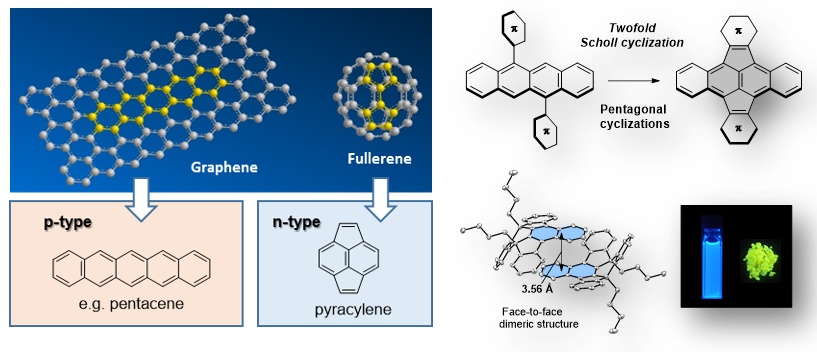Research
Materials Chemistry for the Conversion of Energy
This laboratory currently focuses on projects that include the design and synthesis of functional π-conjugated organic molecules,
metal complexes, and polymers for energy harvesting and/or conversion applications. The development of such materials is of substantial
importance on account of their potential utility in flexible devices, e.g. thermoelectric generators or thin-film photovoltaic cells.
Furthermore, research pursued in this laboratory is concerned with two- and three-dimensional electron-deficient π-systems, in order to
develop n-type semiconducting and low-band-gap materials, as well as intercalation compounds and compounds with solid-state luminescence.

Electron-Deficient Polyaromatic Hydrocarbons
Although a variety of polyaromatic hydrocarbons (PAHs), describing graphene segments containing fully unsaturated hexagonal rings, exhibit a predominantly electron-rich character,
fullerenes with unsaturated hexagonal and pentagonal rings are electron-deficient and can thus be employed as n-type semiconducting materials. The pyracylene skeleton, a key segment
of fullerenes, is particularly interesting due to its antiaromatic character and high electron affinity that arises from the 12 π-electron environment. We have recently reported efficient
synthetic pathways to PAHs that contain a pyracylene moiety, which are based on twofold oxidative C-H coupling reactions of diaryltetracene derivatives. The thus obtained PAHs exhibit
not only an electron-deficient character due to a strong contribution of antiaromatic character, but also unique reactivity, which furnished compounds with a curved or planar π-surface
and distinct emission behavior in the solid state.

π-Extended Metal-Bis(dithiolene) Complexes toward Application in Thermoelecric Devices
π-Conjugation can also be extended by coordination to metals. Recently, one-dimensional (1D) polymers and two-dimensional (2D) nanosheets of π-conjugated metal-bis(dithiolene) units
have received substantial attention, due to their unique properties that include high conductivity and magnetism, as well as their potential use in organic thermoelectric materials.
Whereas the relationship between the solid-state structure and the electronic properties of monometallic bis(dithiolene) complexes with identical π-conjugated units has been studied
in detail, structurally well-defined multimetallic complexes remain largely unexplored, predominantly on account of the difficulties associated with their synthesis. We have recently
established an efficient and versatile method for the synthesis of 2D trimetallic gold-bis(dithiolene) complexes with a starburst structure. Further studies on π-extended metal-bis(dithiolene)
complexes and their polymers for applications in thermoelectric materials are currently in progress in our group.









